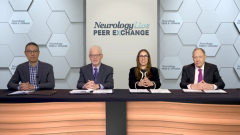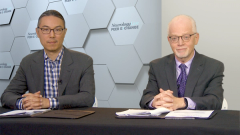
Practice Pearls for Management of NMOSD
Experts in neurology discuss immune tolerance as an alternative strategy and share practice pearls for approaching treatment of NMOSD.
Episodes in this series

Flavia Nelson, MD: I’m curious about what your thoughts are, Brian, on immune tolerance in NMOSD [neuromyelitis optica spectrum disorder] and whether it is an alternative strategy vs the use of the long-term immunosuppressants for management.
Brian Weinshenker, MD: Thanks for that question. Immune tolerance I think is being discussed at quite a bit of length. And I suppose because we know the target antigen for neuromyelitis optica, that always raises the possibility of whether we can suppress the immune response in an antigen-specific way. And in a more natural way, because the FDA-approved drugs are immunosuppressive and they are long-term, and we don’t think that any of them are curative. The idea is, could we reeducate the immune system in an antigen-specific way?
And there has been a study that’s been done in Spain with a very small number of patients to generate dendritic cells that are tolerizing to a variety of antigens, including aquaporin-4 antibodies. And there are some preliminary immunologic data that might show that it’s promising, but there are a variety of approaches, including expansion of T-regulatory-cell vaccinations that might be immune tolerizing. So, I think this is an important direction that’s obviously in a premature stage, but there are a lot of startup companies that are developing these kinds of treatments. And so, I think we have to be open to hearing about this. That would be something that might promise to reeducate the immune system so patients could come off treatments, but that’s a very distant future goal.
At this point, I’m going to turn to each of the panelists and ask, what practice pearls do you have for other neurologists about the management of NMOSD? Aaron, why don’t we start with you?
Aaron Miller, MD, FAAN: Well, management starts with a proper diagnosis. So I would say, don’t screw up and miss the diagnosis. And that means think NMOSD. And I think we should have a low threshold for testing the antibody status in a patient who’s presenting with an inflammatory demyelinating syndrome. Bob, maybe you want to comment on this. I think there are many ophthalmologists already who are screening every patient with optic neuritis, even those who don’t look typically like they’re going to be NMO, for antibodies. But along with the screening, it’s really important to emphasize you have to know the laboratory that’s doing your testing. You need to do a cell-based assay for the anti–aquaporin-4 antibody. And some of the large commercial laboratories are still doing ELISAs [enzyme-linked immunosorbent assays], and that’s not an adequate test.
Brian Weinshenker, MD: Excellent. Flavia, what pearls would you have?
Flavia Nelson, MD: I would say since I’m considered an MRI expert, when you look at the MRI, if you don’t see a lot of lesions in the brain and you see lesions in the spinal cord, again, think NMOSD, especially if the NMO antibody is negative. And remember that it doesn’t have to be large lesions in the spinal cord. You can have NMOSD with small lesions. So again, think of the diagnosis and don’t miss it because you need to treat it properly.
Robert Shin, MD, FAAN: I would agree completely and reinforce that message. We need to accurately diagnose this condition as early as possible to allow us to take advantage of these options. As Dr Miller suggested, I am in the camp of essentially anyone who presents with optic neuritis, a form of transverse myelitis, certainly, an area postrema syndrome, needs to have these antibodies looked for, and it needs to be a cell-based assay for aquaporin-4 antibodies, as well as I would say for MOG [myelin oligodendrocyte glycoprotein].
I would even expand this to maybe our own population of patients who carry a diagnosis of MS [multiple sclerosis]. I don’t think it’s appropriate for every person, but someone with an atypical case, maybe, as Dr Nelson mentioned, the MRI doesn’t quite look MS typical, and perhaps they haven’t responded to our attempts to treat their MS or perhaps they worsened because we really have to test for the aquaporin-4 antibody cell-based assay.
Brian Weinshenker, MD: And I’m entirely on board that the most important thing is getting the diagnosis and being aware of unusual ways in which neuromyelitis optica spectrum disorder can present. I can think of a patient with encephalopathy and a very large butterfly lesion in the splenium of the corpus callosum; that would certainly not have been a patient who one would’ve thought of as having neuromyelitis optica. But this patient was seropositive. And I think it’s just being aware of these various presentations. Hydrocephalus can rarely occur because of the inflammation. So, in a patient who might have a history of optic neuritis and then develops hydrocephalus, to me, that would be suggestive of neuromyelitis optica.
So, I’d like to thank all the panelists and thank all of you for this rich and informative discussion. And before we conclude, I’d like to get final thoughts from each of you. Bob?
Robert Shin, MD, FAAN: I think as we are thinking increasingly about MS, the key for NMO spectrum disorder is to treat it early with a highly effective therapy.
Brian Weinshenker, MD: Excellent. And, Flavia?
Flavia Nelson, MD: I would say when in doubt, refer your patients to a CNS [central nervous system] autoimmune disorder expert or ask for help.
Brian Weinshenker, MD: Good advice. Aaron?
Aaron Miller, MD, FAAN: My final thought goes back to the first patient who I ever confidently felt had NMOSD before we had the SD [spectrum disorder] part. And that was a 10-year-old girl who came to me nearly blind and then developed severe myelitis and ultimately succumbed to NMOSD. So, my thought is how thankful I am that we now have 3 very highly effective agents that we can use to prevent that kind of situation from happening.
Brian Weinshenker, MD: Amen. And I don’t have much to add to that. Thank you for watching this NeurologyLive®Peer Exchange. If you enjoy the content, please subscribe to our e-newsletters to receive upcoming peer exchanges and other great content right in your inbox.
Transcript edited for clarity
Newsletter
Keep your finger on the pulse of neurology—subscribe to NeurologyLive for expert interviews, new data, and breakthrough treatment updates.























